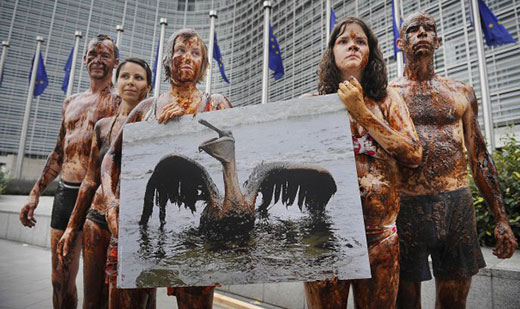
Here’s something troubling for environmentalists to contemplate: Have oil spills become so common, so normal, that the media only bothers to highlight the largest-scale disasters? When 12,000 gallons of crude spilled from a rail car between the Minnesota towns of Winona and Red Wing on Feb. 3, the general response in the news seemed to be a collective shrug of nonchalance. This is worrying, when one considers it’s likely the first of many oil-by-rail accidents of 2014 – and that last year, U.S. rail spilled more oil than at almost any other time in history.
The leak, which the Minnesota Pollution Control Agency said is the result of a cap or valve problem, came from a car on a Canadian Pacific Railway train, which proceeded to drip oil for 68 miles. A major cleanup is not planned, as the size of the leak is considered to be relatively small, compared to other incidents. And yet, officials have admitted it is still not entirely known whether oil has pooled up in places near the tracks they might have missed, or whether the crude poses a threat to any nearby water sources. Regardless, this leak was not widely reported in the news.
For Minnesotan activists who have been paying attention, this incident may evoke a case of déjà vu. In 2009, a Union Pacific train splattered 15 houses on Winona’s East End with oil on its way to Milwaukee. Union Pacific workers initially neglected to report the leak, and it was also not covered by mainstream news outlets. No coverage occurred at all until some workers came forward several days later. Then, like now, it was called a “small leak” and no cleanup efforts were made. Nor, in that case, was the full amount of spillage disclosed.
Notably, Minnesota state law requires that any spill of five gallons or more be reported to the Minnesota Department of Public Safety. Due to the worsening pattern of oil disasters – caused by pipeline and rail transport alike – such a law’s importance is paramount. According to new data presented by the Pipeline and Hazardous Materials Safety Administration, more crude oil was spilled in U.S. rail incidents in 2013 than in the previous 37 years combined. More than 1.15 million gallons of oil are estimated to have spilled from rail cars, and this isn’t even taking into account disasters for which data has not yet been collected, such as an estimated 400,000-gallon spill that occurred Dec. 30 in Casselton, North Dakota, causing derailments and deadly explosions.
The figures also fail to include issues where oil was “mislabeled” as a “Group 3 flammable fluid.” Though such a case has not yet come up in the U.S., from which the data was gathered, it has happened in Canada: The infamous Lac-Mégantic, Quebec spill and explosion was incorrectly categorized, and was not considered a “dangerous oil spill” until an investigation by the Canadian Transportation Safety Board uncovered the error.
It is no coincidence that figures overall for oil-by-rail disasters have increased in North America, as oil delivery by train has become a much more popular form of transport, and has been touted as a “safer alternative” by big oil companies looking to court the favor of those who oppose oil pipelines (like Keystone XL). But as the numbers demonstrate, this mode of oil delivery has been no more successful than its counterpart. Also notable, when taking the uptick of accidents into consideration, is the fact that oil-carrying trains were not always 80-100 cars long as they are today.
Sierra Club executive director Michael Brune remarked of the incidents, “Oil companies cannot be trusted to transport toxic crude through America’s backyards, farmland, and watersheds.” Michael Marx, director of the group’s Beyond Oil campaign, added, “There is no safe way to transport extreme crudes. We don’t need these oils when we are using less oil by raising fuel efficiency and building electric vehicles that use no gasoline at all.”
Photo: Activists with Greenpeace protest big oil and the devastating effects of its spills. Eric De Mildt/AP & Greenpeace










